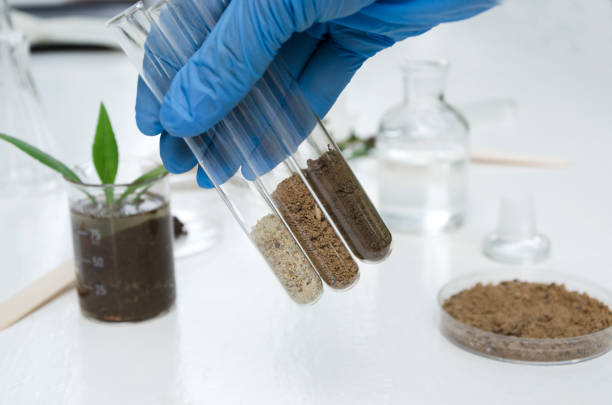The study of the chemical and physical properties of soil helps in managing resources while working with a particular kind of soil. Not all soils have similar properties, and working with them requires understanding soil properties in detail.
Understanding the chemical and physical properties of soil means understanding the soil behavior under different temperature and pressure conditions. Soil mass is always subjected to changing temperature and pressure forces and, depending upon the chemical and physical properties of the soil mass, the necessary actions will be taken. For agricultural and construction purposes, soil properties need to be studied to increase the productivity of soil and to improve the workability of the soil mass, so knowing soil behavior inside out is very important.
Soil properties can broadly be divided into two major categories depending upon their properties achieved during soil formation process.
The physical properties of soil
The chemical properties of soil
Here are some of the physical properties of soil:
Soil Texture

The texture of soil is based on the size distribution of the constituent particles. In simple terms, the relative percentage of clay, sand, and silt in a soil mass determines its texture. Furthermore, the soil texture determines the water retention capacity of a soil sample. Sand particles have the largest diameter, whereas clay particles have smallest diameter, among the three soil constituent particles. The American Association of State Highway Officials (AASHO) and the USDA divide soil texture into twelve classes which are shown in the corresponding figure. Depending upon the percentage of sand, silt and clay in soil, it is defined as coarse, fine, or medium aggregate soil.
Soil Structure
Soil structure refers to the arrangement of sand, silt, and clay particles within a soil mass. Air and water movement through a soil mass directly depends upon the structure of soil mass. Symmetry leads to stability, so if a soil mass has symmetrical or good structure, water and air movement through it will be smooth. However, if the structure is asymmetrical, water and air movement will not be smooth and the soil will be unstable. By knowing soil structure, the moisture content of the soil mass can be worked on, which is equally important for engineering and agricultural works.
Color of Soil
Generally speaking, soils are classified as dark and light colored soils. By looking at the color of a soil mass, a rough idea of the moisture content of the soil, drainage properties, and degree of oxidation can be obtained. A dark color reflects poor drainage, high organic content, and low annual temperatures. On the other hand, light colored soils have better drainage, high annual temperatures, and highly leached conditions. However, these are rough estimates that only help engineers and agriculturists to adopt suitable measures to study soil properties in detail.
Permeability and Porosity of Soil
The ease with which soil will allow water to pass through it is called permeability, which is a very useful value for civil engineers. Constructing a building on highly permeable soil means that water proofing techniques have to be put in place before digging a foundation or raising columns. On the other hand, the porosity of a soil mass means the pore space or void space in a soil mass. It affects the strength of a soil mass and it depends upon other physical properties of the soil like texture, structure, and presence of organic matter in soil.
Chemical properties of soil are discussed in this part.
Acidity of Soil (pH)
From an engineering as well as an agricultural point of view, determination of the pH of the soil mass is essential. For healthy plants to grow, the acidic and basic nature of soil must be known. On the other hand, for construction works, highly acidic soil will affect the bitumen stability of roads and have adverse effects on concrete strength. (Salinity of soils will also increase maintenance costs.)
Silicate Clay Presence
The presence of silicate clay materials affects the chemical properties of soil mass. Clay particles have a large surface area and are the finest materials present in a soil mass. Clay particle increase the reactivity of a soil mass and affect the stability of the soil mass by forming compounds with external materials. Determination of silicate clay presence is important to find out the reactivity of the soil mass and its compatibility with admixtures and construction materials used with concrete.
Cation exchange capacity and the presence of organic matter are two other chemical properties of soils.
Index Properties Determination
Shrinkage characteristics, liquid limit, plastic limit, and different densities of soil are called the index properties of soil mass. These properties are determined using different laboratory index test methods. Collectively these properties are known as Atterberg Limits and are valid only for fine grained soils.
The plastic limit of a soil mass, or the point at which a soil ceases to be plastic and starts to crumble, is determined using the Casagrande method (apparatus shown adjacent), which also helps in the determination of the liquid limit of soilmass. Knowing these properties helps in calculating shear stress actions on soil mass and the behavior of the soil in changing moisture conditions.

Other important index test soil properties methods are listed below.
Pyknometer (specific gravity bottle) test to determine particle density and specific gravity of soil mass
Volumetric shrinkage test to determine shrinkage properties of soil mass
Particle size determination using hydrometer test
Cone penetrometer (fall cone) test to determine liquid and plastic limits, which is often considered superior to testing with the Casagrande method


